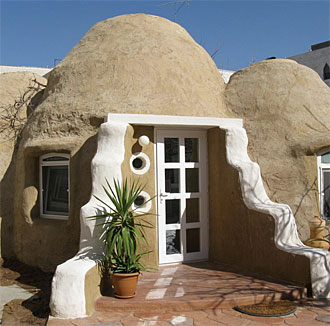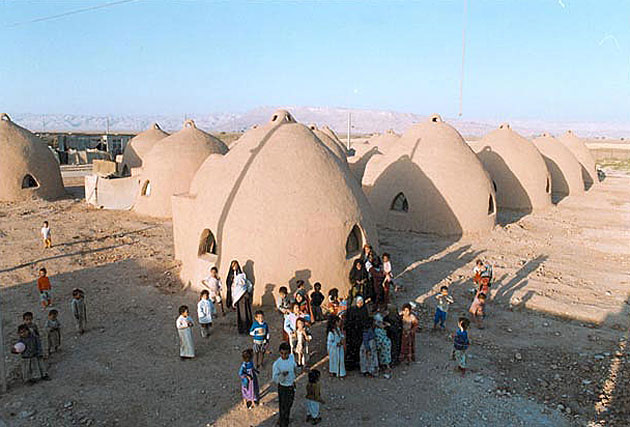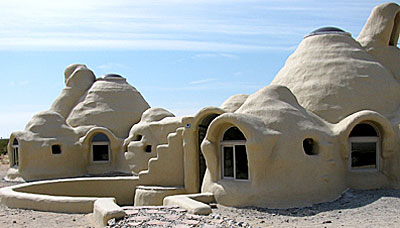Superadobes
Almost a third of the world's population lives in dwellings made
from earth. As we become more concerned with our use of natural
resources, this is expected to increase. Advances in technology
now make it possible to very effectively build using superadobe
construction (the super-duper version of regular adobe
houses).

Superadobe |
|
The materials for a superadobe wall are simple - just barbed
wire and sandbags filled with earth. For eons, sandbags have been
the chosen materials for building dikes, and have also been used
for protection in war zones. Once these temporary structures served
their purpose, the sandbags were emptied and disposed of. Today,
superadobe (or superblock) construction is used for permanent
construction.
In the past, the main problem using sandbags for construction
has been that they lack tensile capability, which means that the
structures being built had to be low. It was also impossible to
create domes or arches. With superadobe construction, barbed wire
is placed between the layers of sandbags in order to create tensile
resistance. Shear stresses are transferred from one sandbag to
the next. Bigger sandbags can be used, so walls can be made higher.
It is also possible to create vaults, arches and domes.
Superadobe sandbags are
tubes made of fabric. They are filled with different
types of particulate, fluent material, which may include earthen,
organic sand along with manufactured or recycled materials that
then become self-supporting, forming into a block. The bags themselves
are coated with protective materials, meaning that durable exteriors
do not need to be shielded.

Because of the flexibility of the sandbag, monolithic structures
can be built in curved forms, completely from earth. Most traditional
roofing systems can be eliminated.
Single-curvature and double-curvature
compression shells don't transfer stresses from
element to element. Instead, stresses are transferred along the
structure's surface. With beam and column construction, when a
single element becomes overloaded to the point of failure, adjacent
elements are affected, and they all fail. This frequently results
in the collapse of the entire structure. With a domed structure,
excessive loads are shed with localized failure and the remainder
of the structure remains intact.
Live-load and dead-load stresses transfer to the ground, spreading
evenly along the dome or bearing wall's perimeter. With beam and
column structures, the loads get transferred by way of a footing
underneath each column. This results in severe stresses to the
upper structure that can cause cracking, particularly when there
has been frost-heave. This is why most foundations go below the
frost line. In a monolithic structure, frost-heave and differential
stressing don't present these problems. The structural load is
distributed over a larger area, so "soft spots" in the
soil have negligible effect.
One of the greatest challenges
in modern construction is creating structures that
will withstand natural disasters like earthquakes. As our climate
changes, this will continue to be of concern. The basic shape
of most structures creates problems, since the weight of the structure
is not evenly distributed between roof and foundation.

Frequently, there is a good deal more weight on the upper floors,
and deep foundations and footings can come apart at the structure's
base. There are designs that can provide shifting capabilities,
but they are often cost-prohibitive. A vaulted or domed structure
can be expected to be much more stable in the event of an earthquake.
The continuous foundation can actually slide across the ground
as it moves, while the upper structure resists damage.
Conclusion
Superadobe, using hand-filled or pump-filled sandbags combined
with four-point barbed wire, is a highly effective construction
method. It is eco-friendly, and lends itself very well to structures
that can be designed to withstand even earthquakes.
|

